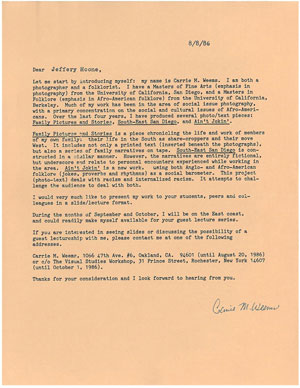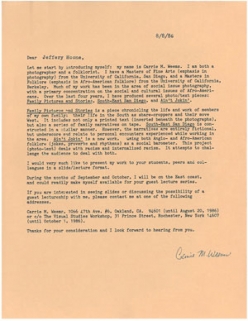From the Files: Carrie Mae Weems
 For over the 30-plus years Light Work has been supporting emerging and under-recognized artists working in photography. In the course of that time running a residency program, staging exhibitions, hosting lectures, and publishing Contact Sheet, we have accrued quite an archive of files. In fact, one wall of the Light Work offices is taken up by these hundreds of files, all organized by artist name or project. Light Work has worked with ground-breaking artists, many of whom have gone on to become inspirational and influential in the art world. Our files act as a historical record not only of our mission but of 20th and 21st century photography in general. From the Files gives a unique glimpse into how Light Work has helped artists early in their careers, and how these artists in turn have contributed their talent to our mission.
For over the 30-plus years Light Work has been supporting emerging and under-recognized artists working in photography. In the course of that time running a residency program, staging exhibitions, hosting lectures, and publishing Contact Sheet, we have accrued quite an archive of files. In fact, one wall of the Light Work offices is taken up by these hundreds of files, all organized by artist name or project. Light Work has worked with ground-breaking artists, many of whom have gone on to become inspirational and influential in the art world. Our files act as a historical record not only of our mission but of 20th and 21st century photography in general. From the Files gives a unique glimpse into how Light Work has helped artists early in their careers, and how these artists in turn have contributed their talent to our mission.
As a case in point, in 1986 Carrie Mae Weems wrote this letter (click to enlarge) to then Director Jeff Hoone to introduce herself and offer to give a lecture at Light Work. In the letter Weems gives brief descriptions of her series Family Pictures and Stories, South-East San Diego, and Ain’t Jokin’.
Weems went on to be a Light Work Artist-in-Residence in 1988. Her contributions to Light Work include seven pieces in the Light Work Collection, exhibitions in 1996 and 2003, and the donation of prints to the Eatonville Portfolio and to our 2011 Subscription Program, which features an image from the Kitchen Table series. Her work is included in Contact Sheets 61, 97, and 124.




Just wondering if Carrie Mae Weems was consulted before her correspondence to Jeffrey Hoone was posted here? I ask because she is still alive and the letter is addressed ” Dear Jeffrey Hoone”, not “Dear World”. 🙂
As an artist, I’m particularly sensitive to the larger issue that, in this digital age, many things go online because it is technologically possible to put it there. But how does that affect the “erosion” of ethics and how these uses are gradually accepted as normal.
Dear D. Saunders, These are all great questions about private vs. public and how we need to safeguard a comfortable division between the two. Our archives are carefully screened to ensure that no overly personal information is shared either online or when people research the physical archive in our facility. The letters and other ephemera in our files provide a glance into the history and texture of our organization and collaborations with artists; they tell a story in a way no other source could. Thank you for your comment, and I’d enjoy discussing this with you further. —Mary Goodwin, Associate Director